truss, n. A collection of timbers or members forming one of the principal supports, as of a roof or bridge, and framed together so as to give mutual support and prevent distortion, as by the forces of gravity and wind loads.
Wood trusses, whether structural or decorative, are usually named in one of five ways: 1. from the construction in which they are used; as in, roof truss or bridge truss, etc.; 2. from their form; as in, lenticular truss, etc.; 3. from their resemblance to certain objects; as in, scissors truss, etc.; 4. from some prominent feature in their construction; as in, king post truss, hammer beam trusses, etc.; 5. from the person by whom they were in invented; as in, Howe truss, etc. (adapted from the Funk & Wagnalls Company 1943 Standard Dictionary of the English Language)
Timber Frame Truss Types
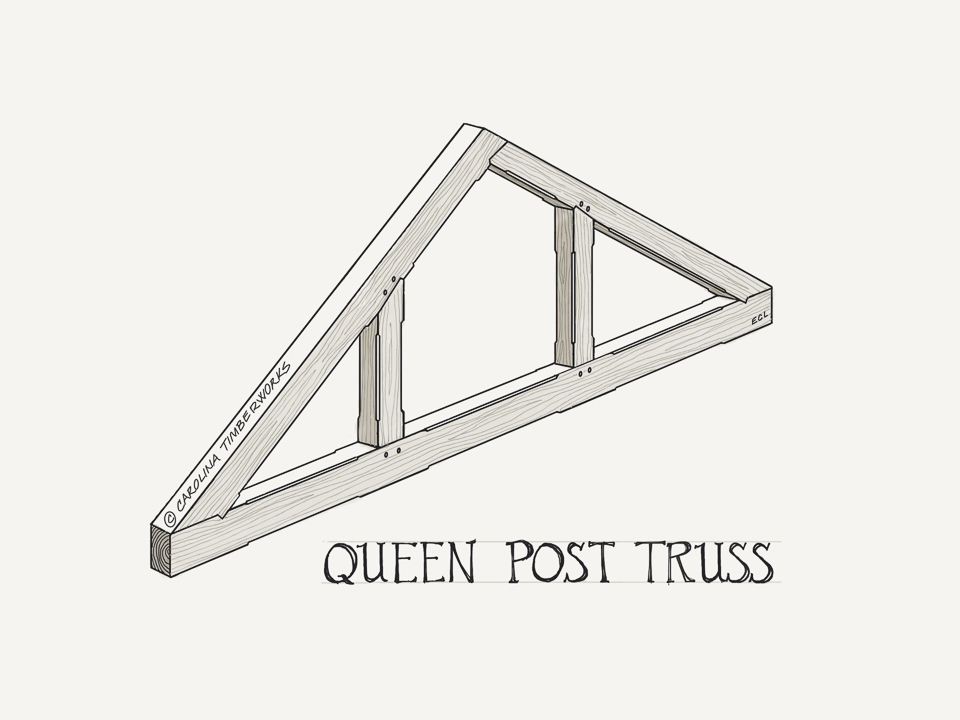
Queen Post Truss
The queen post truss with with paired queen posts is a classic truss design, with many variations. The basic double posted version may also have a horizontal crossmember between the two verticals. Additionally, diagonal braces and/or struts may be added for increased strength and visual appeal.
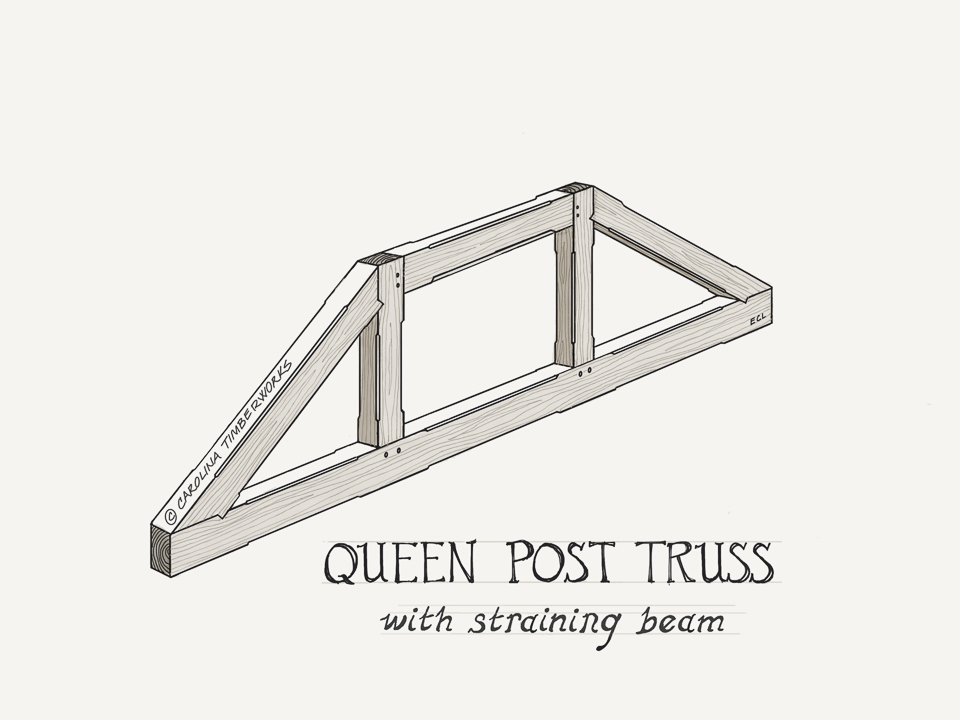
Queen Post Truss with Straining Beam
The queen post truss with straining beam between the tops of the posts (the true queen post truss), forms a configuration capable of much longer spans. Wood trusses of this type have been developed for distances over 50′. Straightforward geometry and pleasing lines make it timeless and honest.
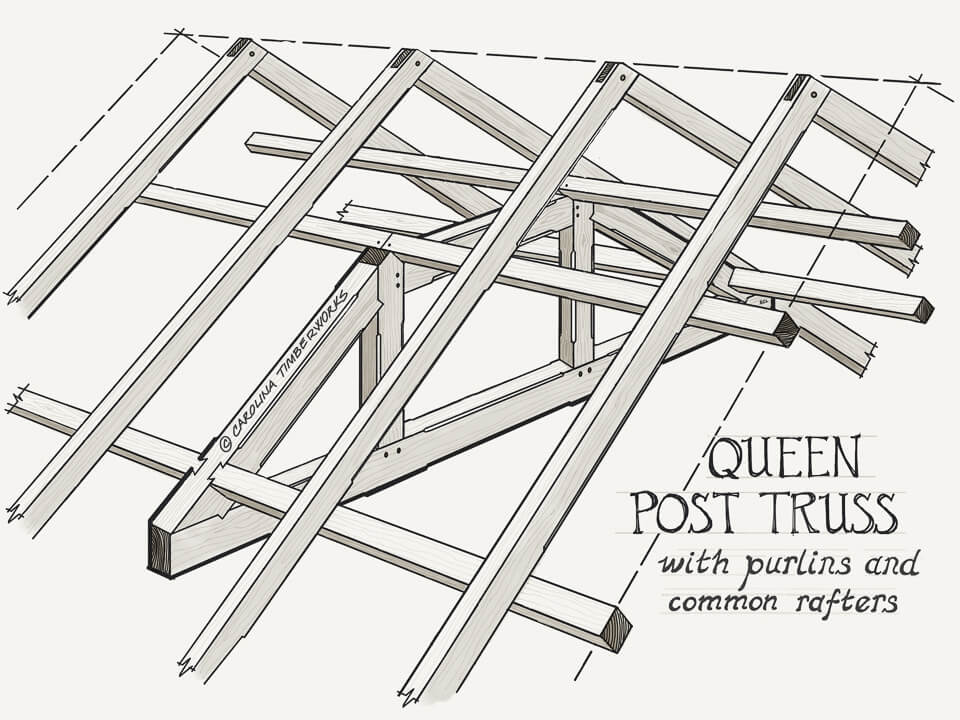
Queen Post Truss with Purlins and Common Rafters
Queen post trusses can be integrated with smaller members to form a more complex roof system. In this version, purlins are placed between wood trusses, to support pairs of common rafters above. These 3 components merge aesthetics and structure to create a striking multi-layered timber frame roof. Note that the tops of the purlins are a great place to hide indirect lighting.
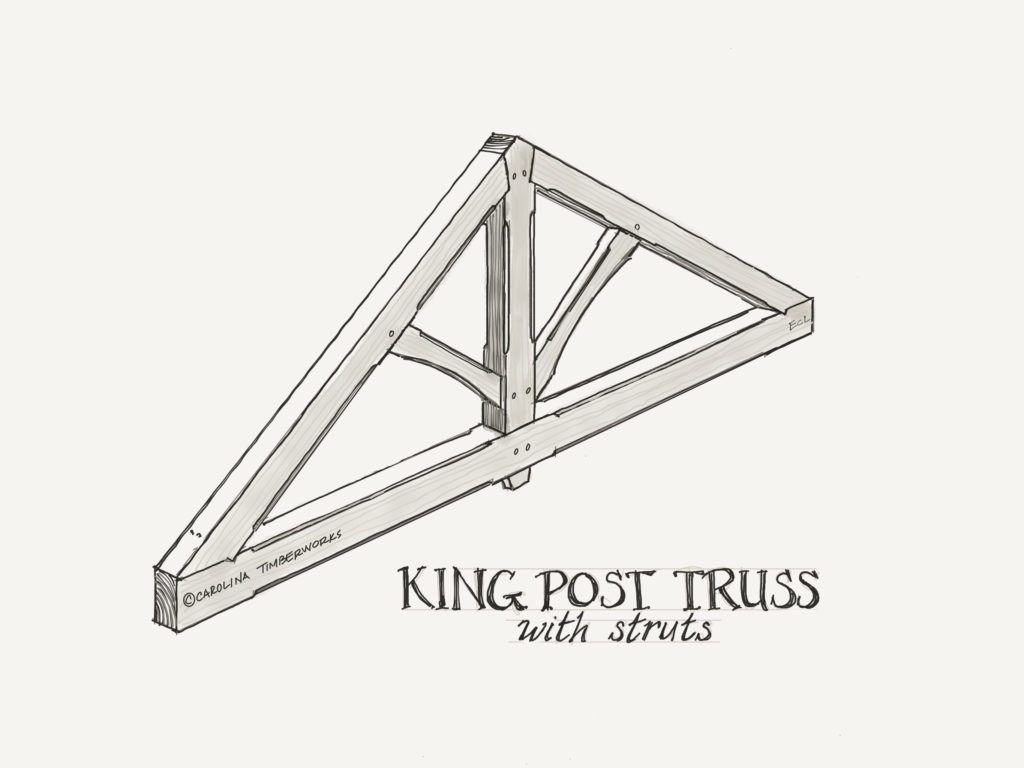
King Post Truss
The king post truss with struts is popular, timeless, very strong, and an elegantly simple truss design. This style can be embellished with radius cuts on the struts and a through tenon at the base of the king post (as pictured above). This truss is very adaptable with regard to desired span and roof pitch.
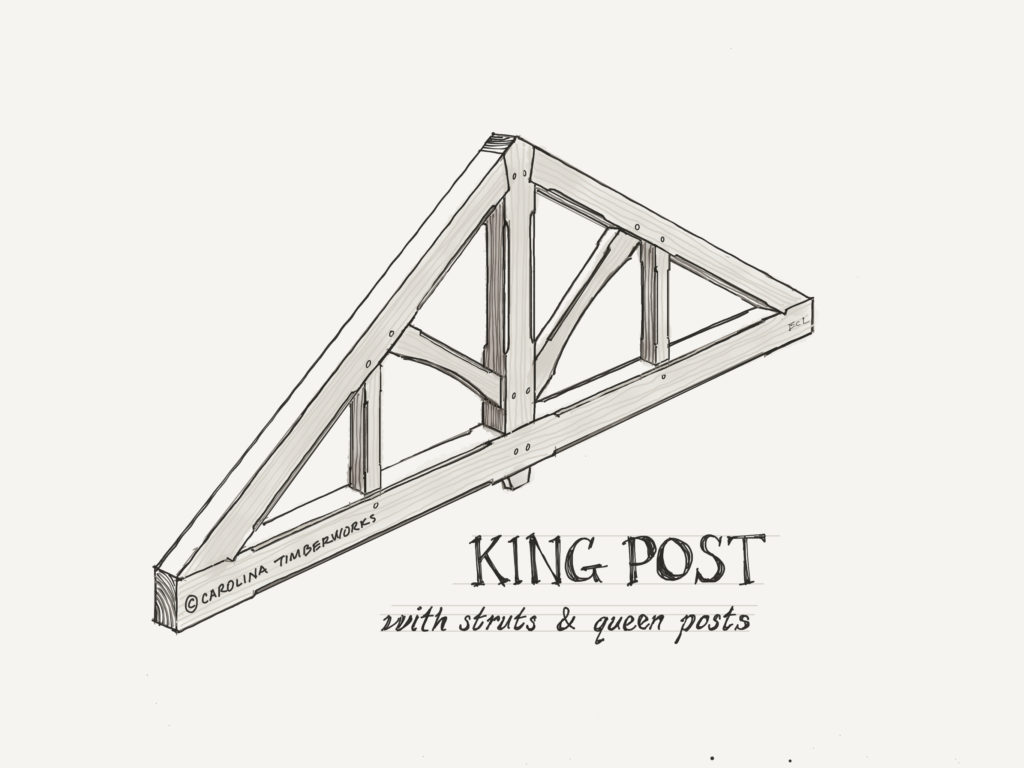
King Post Truss With Struts and Queen Posts
The king post truss with struts & queen posts is based on the popular king post truss design, but with the addition of two queen posts (pictured above). This timber truss is also very strong, and adaptable with regard to desired span and roof pitch. This arrangement is particularly good for longer timber frame truss spans (in excess of 24’ feet).
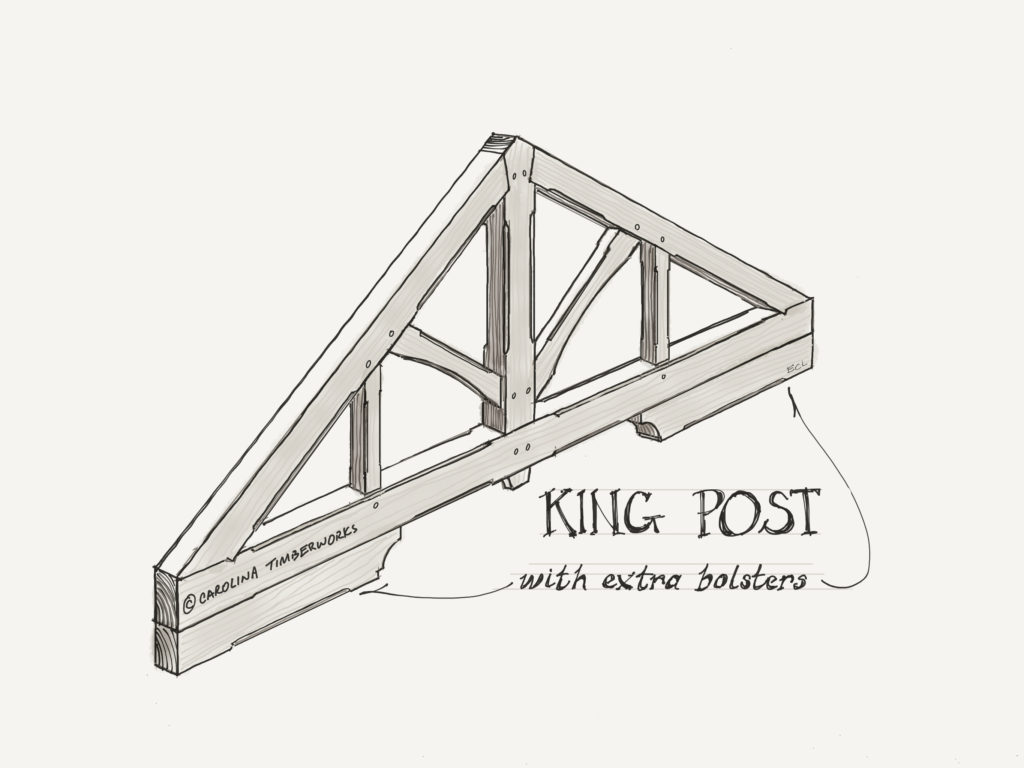
King Post Truss With Extra Bolsters
The king post truss with extra bolsters builds on a favorite timber truss design with two added bolsters on the underside of the bottom horizontal chord for a heftier look. These mirror image pieces added to the underside of the bottom chord can provide a stepped transition to the vertical wall plane. The bolsters can have a wide variety of decorative profiles cut into their visible ends. Twin metal straps can also be banded around both the bolster and the bottom chord for a craftsman detail.
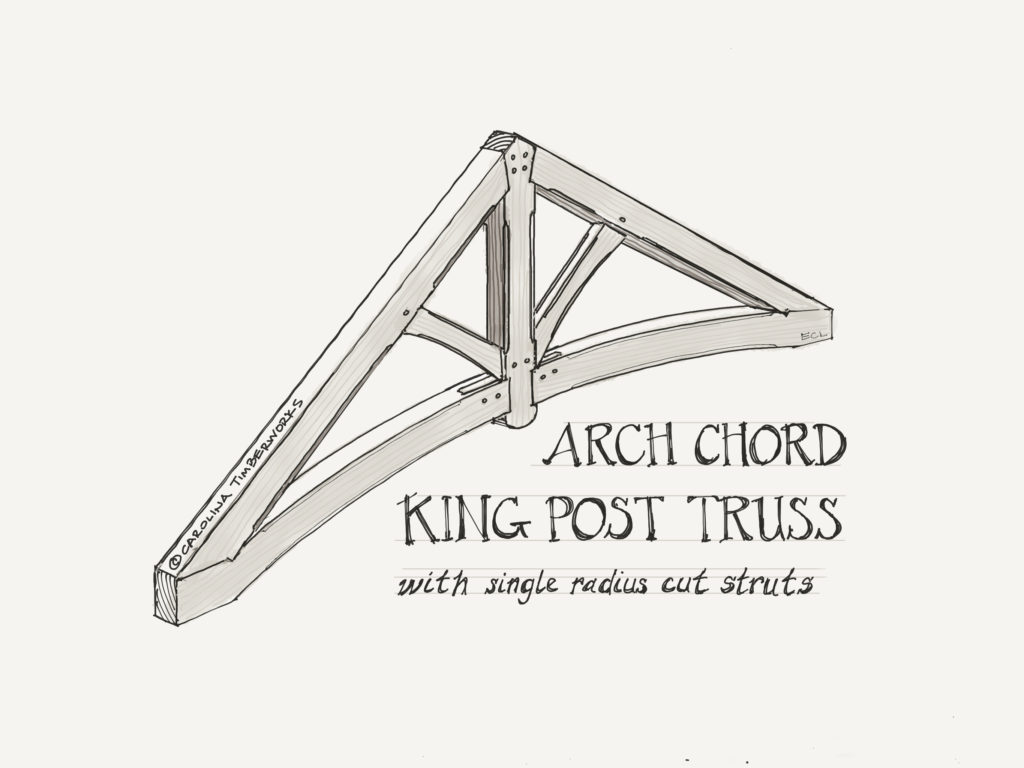
Arch Chord King Post Truss
An arch chord king post truss is another variation on the classic king post style, this time with an arched lower chord. This design adds a curvilinear element into the ceiling space instead of the standard horizontal timber, raising the structure somewhat and giving some extra volume below. Some of our clients have pointed out how the curves in this timber frame truss soften the lines and convey a natural aesthetic (after all, there are very few straight lines in nature). The radius cut for the arch should be shallow in order to be cut out of solid sawn timber. However, more semi-circular arches can be accommodated by using a grain matched glue laminated arch material (this is considerably more expensive than solid sawn timber).
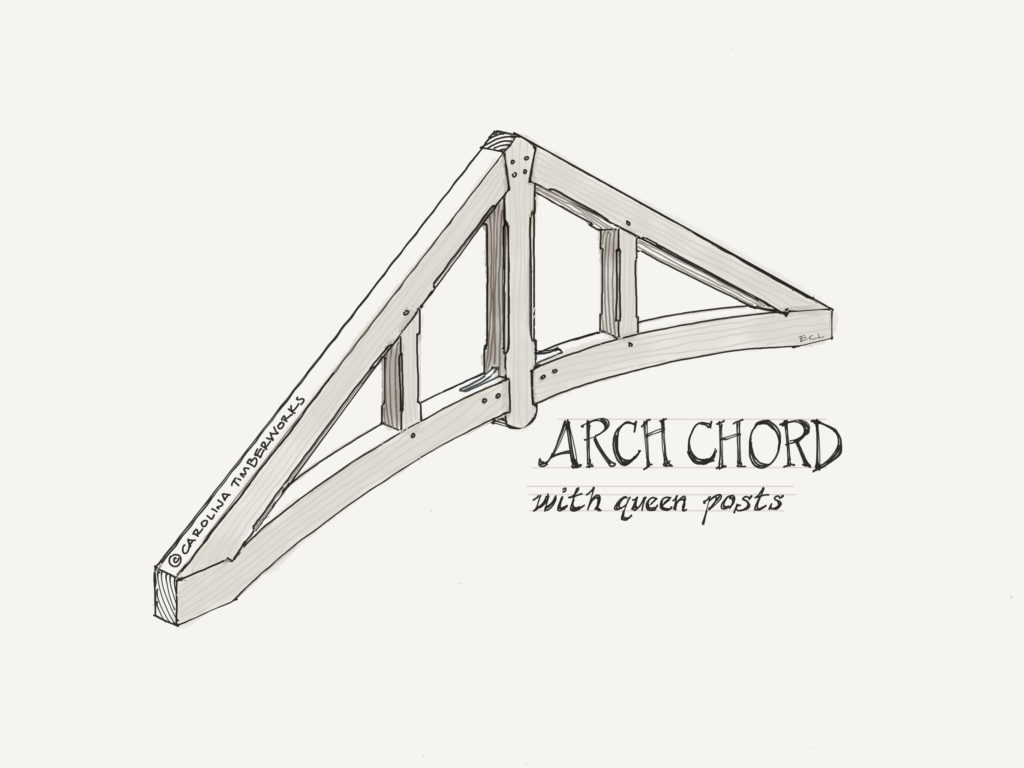
Arch Chord With Queen Posts Timber Frame Truss
The arch chord with queen posts timber frame truss is another variation on the classic king post style, this time with twin vertical queen posts. This design adds more vertical elements above the arched bottom chord with the extra volume below. The radius cut for the arch should be shallow in order to be cut out of solid sawn timber. We like to use a spline tenon to joint the 2 half arches to the base of the king post. On larger spans, this configuration often requires concealed steel connectors to resist tension and spreading along the arch itself.
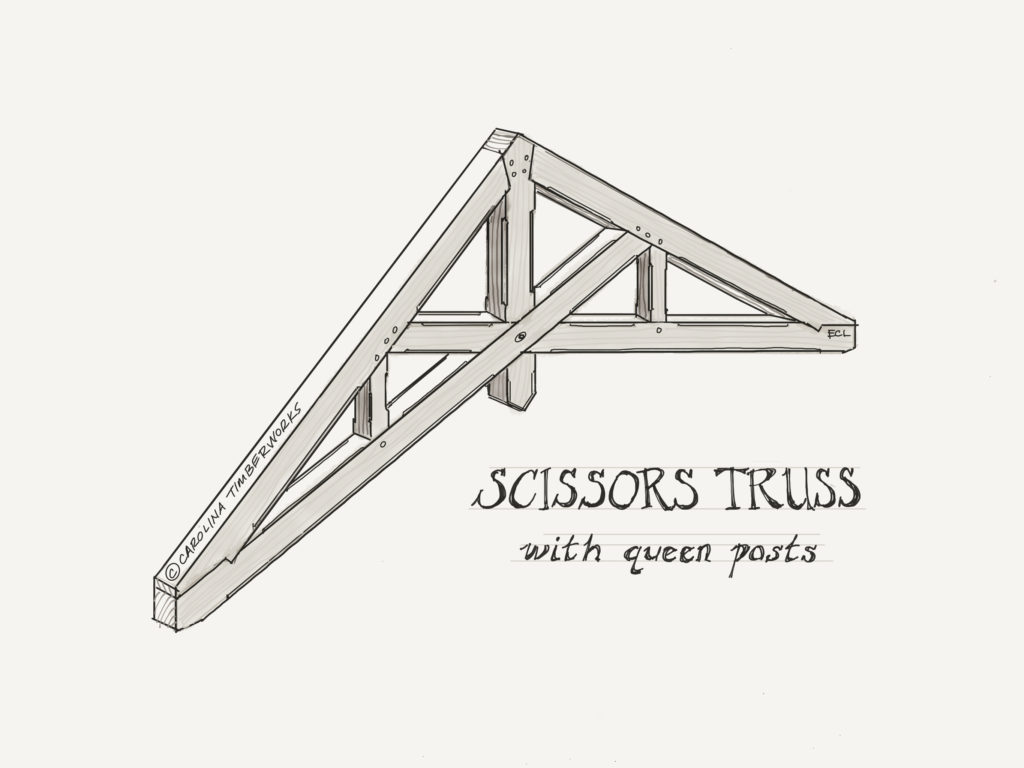
Scissors Truss
A scissors truss is a traditional truss style with many variations, this design can be used in small or large spans. Scissors trusses are not recommended for shallow roof pitches ( below 8/12 pitch ). We like to add the queen posts on either side of the central king posts. These timber frame trusses have a more complicated geometry with many angled intersections and a higher center for added space.
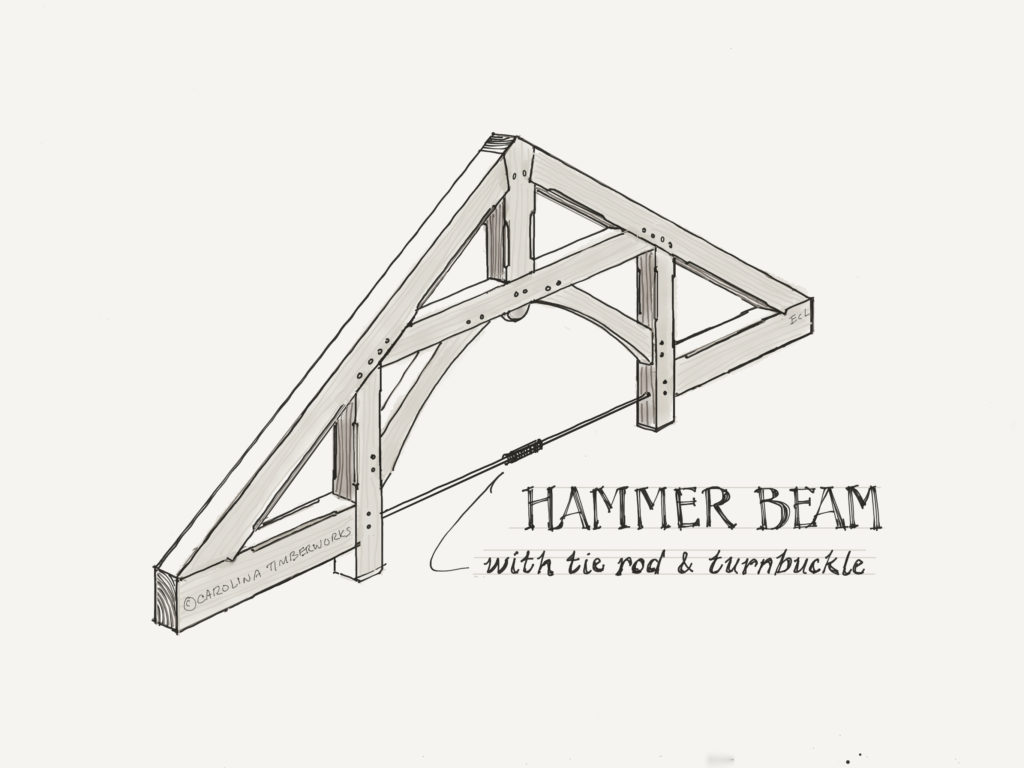
Hammer Beam Truss
A hammer beam truss is based on the more elaborate hammer beam timber frame bent design. The combination of heavy timber and metal tie rods and turnbuckle is not only appealing but is often required to handle the spreading forces this configuration will develop. In case you were wondering, a hammer beam is a short beam projecting laterally from the inside of a wall, and serving as a tie beam.
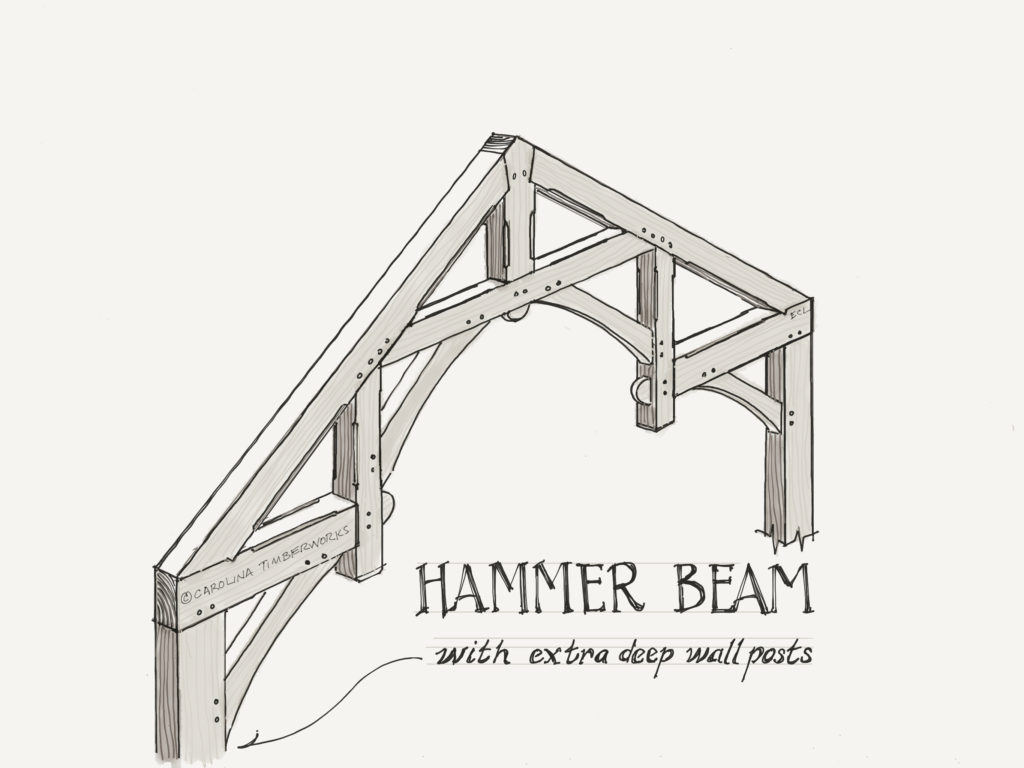
Hammer Beam Truss
A hammer beam truss, pictured above, is a beautiful and more complicated design, and creates dramatic vaulted spaces. There are many ways to embellish this design, from through tenons and radius cuts to decorative pendants or finials. The hammer beam bent is often associated with religious structures, great halls, or great rooms. Without a metal tie rod and turnbuckle, deep wall posts and/or concealed steel connectors are needed to handle the forces this configuration will develop.
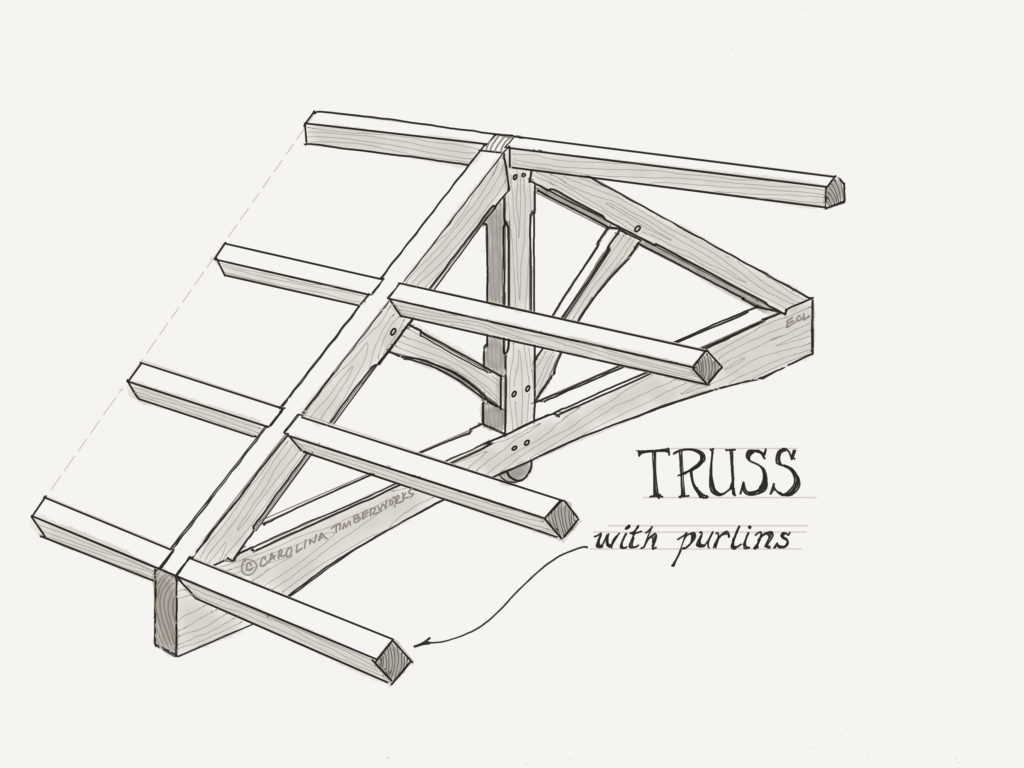
Truss with Purlins
Truss and purlins: adding purlins between heavy timber trusses is an elegant way to reduce the cost of a timber frame roof because purlins permit an increased on-center distance between trusses (so you purchase fewer trusses). An added benefit are the strong lines that purlins create by running parallel to the ridge beam(s). (Another benefit is that purlins are a great place for placing LED lighting fixtures). Purlins often sit in pockets cut into the truss rafters (as shown) but can also sit on top of the truss rafter to create a secondary layer to the roof structure. There are some span restrictions based on the purlin size ( beam width x depth) and how close they are together. This is a very traditional concept in heavy timber roof framing. (purlins are a series of horizontal timbers laid across (or connected to, as depicted above), the principal rafters, and support the roof covering–typically 2×6 tongue and groove boards, conventional or structural insulated panels (SIPs), and roofing)
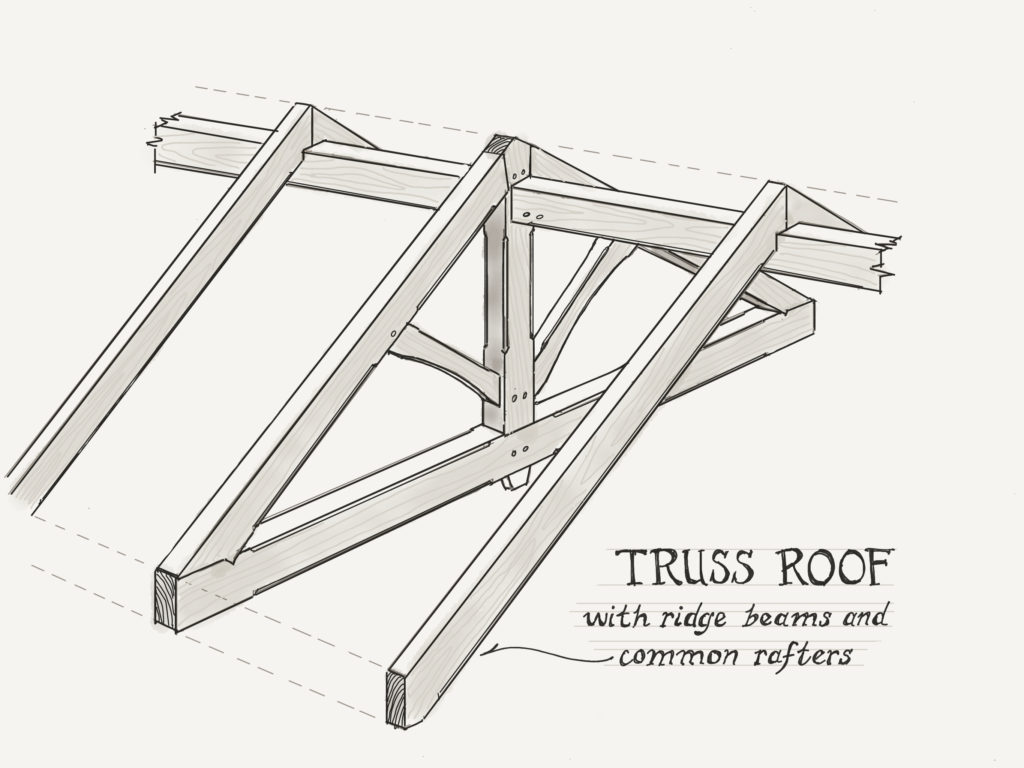
Truss Roof With Ridge Beams and Common Rafters
A truss roof with ridge beams and common rafters can provide a larger space between each truss. We like common rafters between each truss thereby giving a rhythm to the roof structure. The common rafters are often smaller than the truss timbers to differentiate between the primary and secondary timber frame elements.
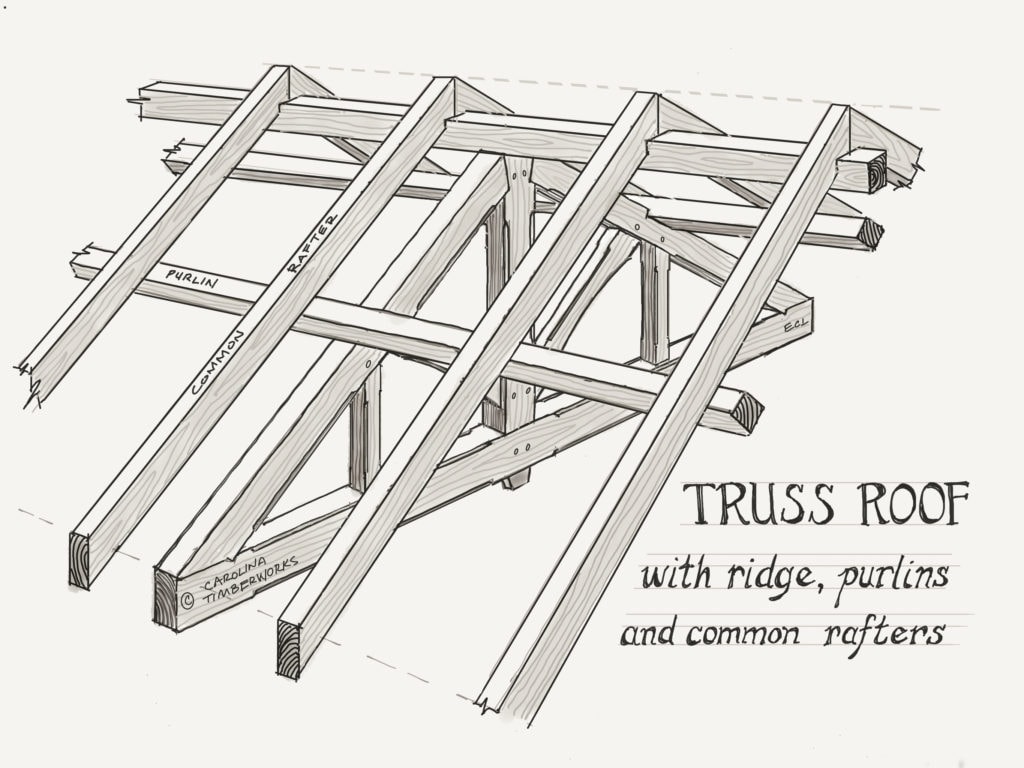
Truss Roof With Ridge Beam, Purlins, and Common Rafters
A truss roof with ridge beam, purlins, and common rafters is a stunning combination that creates visual interest and structural complexity. There is a hierarchy of timber framing at work here, with trusses supporting the ridge and purlin beams. Above these components is a rack of common rafters. Typically wooden trusses are made from the biggest timbers, followed by intermediate sized ridge and purlins followed by the common rafters as the smallest timbers. One of our favorite combinations!
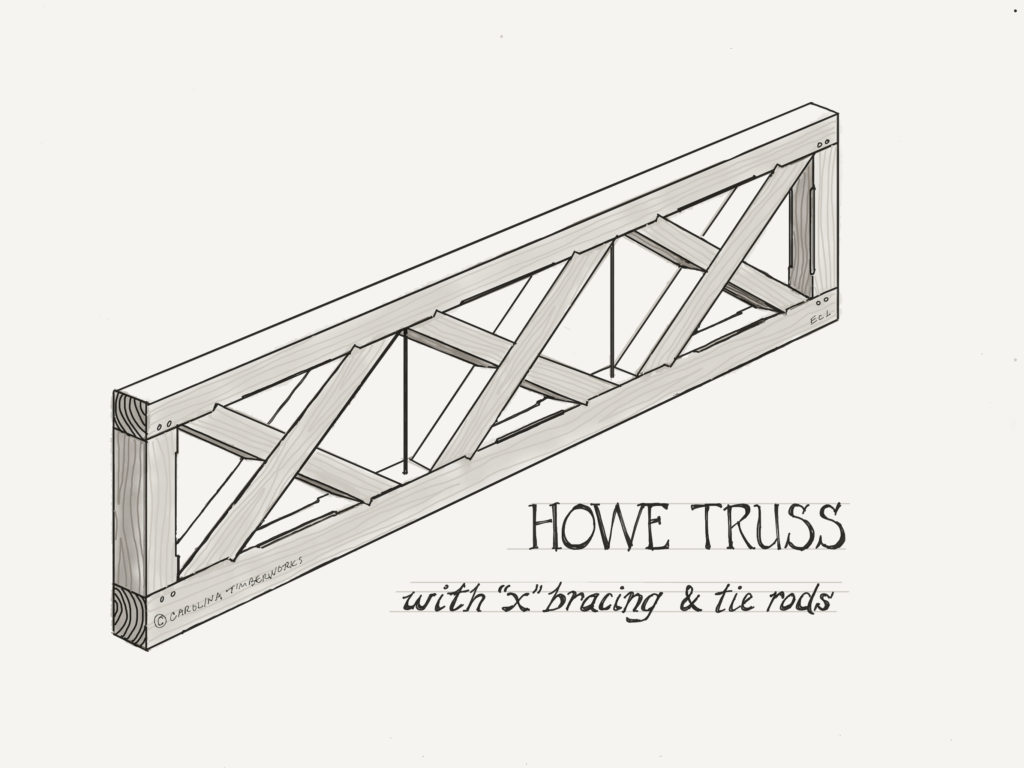

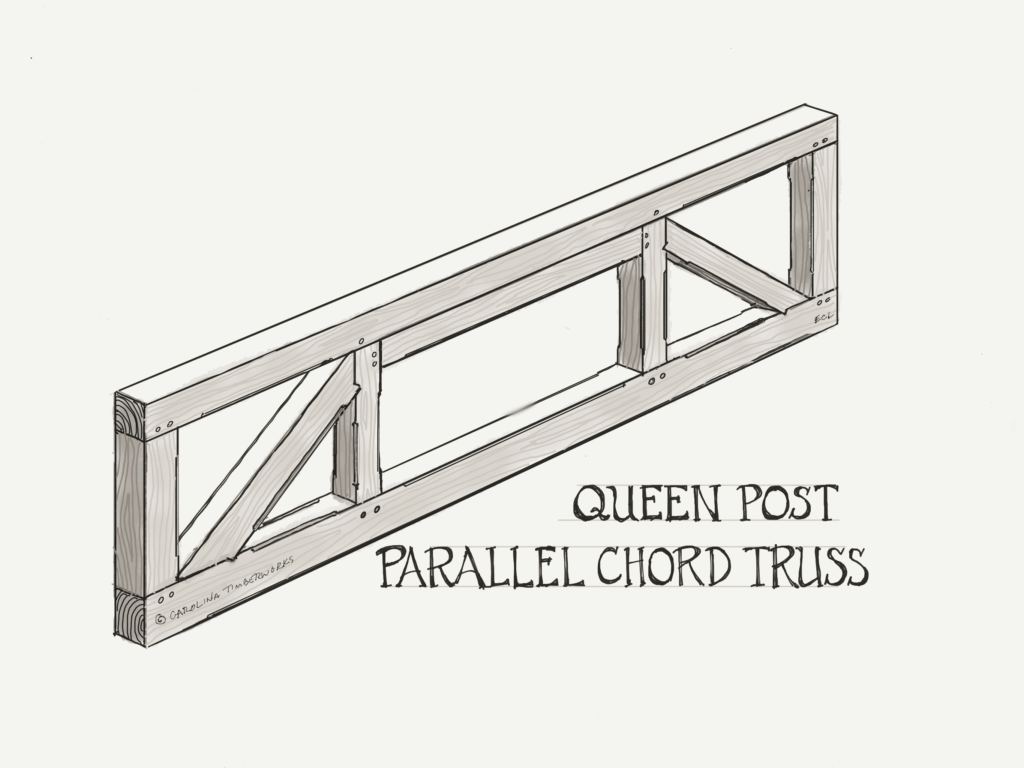
Bridge Trusses
The Howe, Warren, and Queen Post Parallel Chord Trusses, sometimes referred to as Bridge Trusses are relatively simple designs used in the construction of everything from the earliest 19th century modern bridges to WW II aircraft hangars. They’re efficient, strong, and characterized by the joining of numerous smaller members into a series of interconnected triangles. In addition to being a proven way to solve the engineering problem of long spans, we think they look great in modern timber framing (see an example here) and are one of the best examples of form following function.
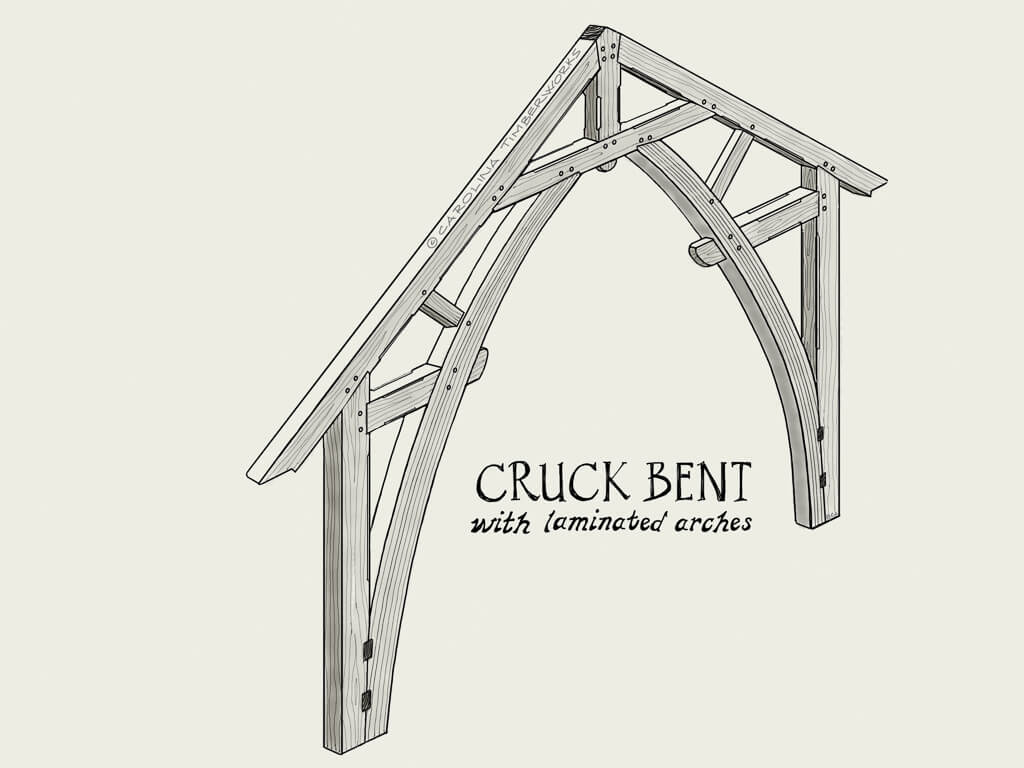
Cruck Frame Bent
Cruck Frames, found primarily in the UK, were the original A-frame. According to Cruck Building: A Survey, the definitive definition of a cruck is as follows: “a true cruck consists of a pair of timbers (blades), straight or curved, serving as the principals of a roof, and stretching to point at or close to the apex of the roof, from a level well down the side walls.”
Learn More: Our Timber Frame Glossary
Copyright 2019 Carolina Timberworks. All rights reserved. Illustrations by Eric Lubsen.